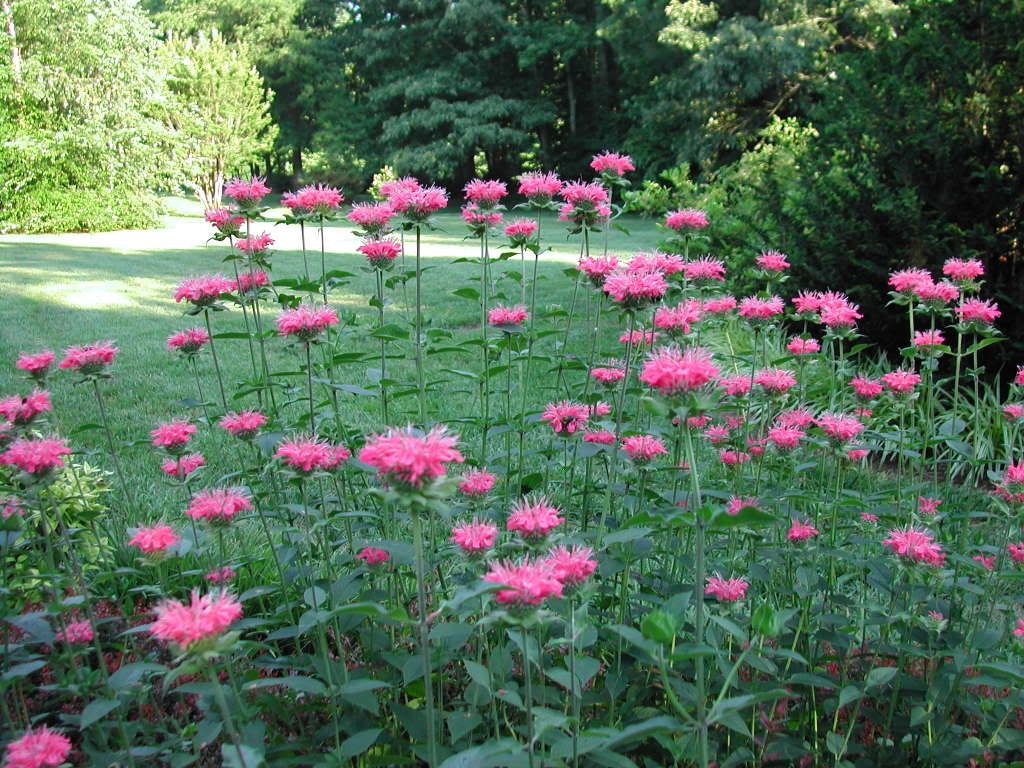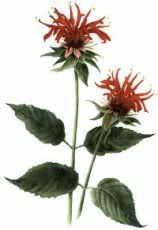
Other Names: Eastern Beebalm, Bergamot, Wild Oswego Tea, Horsemint, Monarda
Bee Balm Herb Uses and Medicinal Properties
Bee Balm is edible and medicinal, the entire plant above ground is edible used as a pot herb, and it is also used as a flavoring in cooked foods. The flowers make an attractive edible garnish in salads. The plant is noted for its fragrance, and is a source of oil of thyme. The fresh or dried leaves are brewed into a refreshing aromatic and medicinal tea. An infusion of young Bee Balm leaves used to form a common beverage in many parts of the United States.

Bee Balm leaves and flowers and stems are used in alternative medicine as an antiseptic, carminative, diaphoretic, diuretic and stimulant. An infusion is medicinal used internally in the treatment of colds, catarrh, headaches, and gastric disorders, to reduce low fevers and soothe sore throat, to relieve flatulence, nausea, menstrual pain, and insomnia. Steam inhalation of the plant can be used for sore throats, and bronchial catarrh (inflammation of the mucus membrane, causing an increased flow of mucus). Externally, it is a medicinal application for skin eruptions and infections. Bergamot's distinctive aroma, found in both the leaf and flower is wonderful for use in potpourri.
While a fragrant herb in its own right, Wild Bergamot is not the source of the commonly used Bergamot Essential oil.

Habitat and Description
Bee Balm is a perennial herb native to Eastern North America. It grows in dry thickets, clearings and woodland edges from Ontario and British Columbia to Georgia and Mexico. Bee Balm has showy, red, pink, or lilac flowers in large heads or whorls of about 20-50 flowers at the top of the branching stem, supported by leafy bracts, the leaflets are a pale-green color. The stem of Bee Balm is square, grooved and hard; and about 3 feet high. The leaves occur in opposite pairs, are rough on both surfaces, are distinctly toothed, and lance-shaped. Fine dense hairs cover much of the stem and leaves. Bee Balm roots are short, slender, creeping rhizomes.
How to Grow Bee Balm
Bee Balm is easily grown in ordinary garden soil. It also grows well in heavy clay soils, requires a part shade to sunny place to grow. This species thrives when grown in a dry soil and prefers alkaline soil conditions. Bee Balm is best started from plants which spread like crazy, but will grow from seed as well. Unfortunately, it often gets spotted with a mold like affliction.
How to Harvest and Use Bee Balm
Wild Bergamot flowers bloom from June to July. Gather edible leaves and flowers in bloom, dry on small bundles in paper bags in a dry, well ventilated area. Bee Balm can be used as tea, or as an aromatic suitable for sachets and potpourri.

Herbal Tea Recipe
"Medicinal" tea: To 1 tsp. dried herb, add 1 cup boiling water, steep 10 min. sweeten to taste, take at bedtime.
Folklore and History
The red variety is commonly known as Oswego Tea. It was used by colonists in place of English Tea after the Boston Tea Party, when they threw the English tea in the harbor to protest the high taxes imposed on it by the British. Read More about Oswego Tea
Bee Balm was used as a medicinal plant extensively by Native Americans who recognized four varieties that had different odors. Wild Bergamot was used also as an active diaphoretic (sweat inducer) for ceremonial sweat lodges. A decoction of the herb was made into hair pomade.
I honestly don't know if I've ever seen this plant or not...I know I've looked at it in books and catalogs but to see it up close and personal, I don't think so. One more thing to plant around here, lol! I noticed the honey bees were here this year, not many but they were here so maybe this would encourage more to come?
ReplyDeleteGood to see you here Sister Love! :)
I love you more today than yesterday!
(((Big Hugs)))